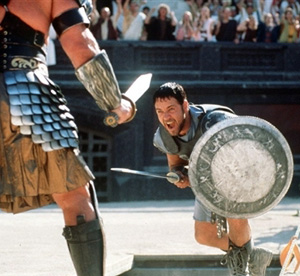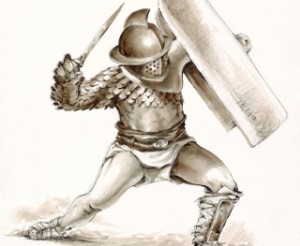Ancient Roman Gladiators Facts – Types and Training
Ancient Roman gladiatorial combat was famed for its brutality and spectacle, with man and beast alike fighting for glory, freedom and, ultimately, survival.
Throughout the Roman Empire, gladiatorial combat was one of the most watched and celebrated forms of popular entertainment. Men, women and animals shed each other’s blood in a fierce arena where, more often than not, there were only ever two basic choices: to kill or be killed.
Roman gladiatorial combat emerged in the 3rd century BCE in Campania, southern Italy, as part of funeral rites, with combat- simulated or not – put on as part of commemorations. It quickly evolved, growing in both stature and lavishness with increasingly large celebrations. By the 1st Century CE it peaked with the adoption of gladiatorial combat into state-held games – extravagant, month-long celebrations put on for victories, coronations and religious dates. This upscaling in the size of the events led to the creation of dedicated gladiatorial schools, where slaves, convicts and prisoners were forced to fight.
The gladiator schools were run by a school head (or lanista), who would acquire potential gladiators, then house and train them over a series of months or even years. The school would then either lease or sell gladiators to the state or private families. Nobles often invested in them and were encouraged to as it was seen as an acceptable business for the upper classes. Interestingly, while it was deemed proper for the aristocracy to own gladiators, the heads of gladiatorial schools were perceived as lowly members of society, with most referred to as nothing more than common slavers.
 Gladiator training was equally complex. Far from each person solely being trained to fight with a simple sword and shield, in fact individuals were categorized into a number of gladiatorial types, each differing in arms, apparel, armour, accessories and technique. Indeed, records show that there were over 20 different kinds of gladiator, ranging from retiarius net fighters, through to cestus fist-fighters and on to dimachaerus dual-weapon fighters, among many others. Importantly, specific gladiators were paired against others of their same class, or those from one that complemented them, the latter designed to provide greater entertainment. For example, the smooth-helmeted secutores were often pitted against retiarius as the latter’s net generally struggled to capture secutores.
Gladiator training was equally complex. Far from each person solely being trained to fight with a simple sword and shield, in fact individuals were categorized into a number of gladiatorial types, each differing in arms, apparel, armour, accessories and technique. Indeed, records show that there were over 20 different kinds of gladiator, ranging from retiarius net fighters, through to cestus fist-fighters and on to dimachaerus dual-weapon fighters, among many others. Importantly, specific gladiators were paired against others of their same class, or those from one that complemented them, the latter designed to provide greater entertainment. For example, the smooth-helmeted secutores were often pitted against retiarius as the latter’s net generally struggled to capture secutores.
Upon arriving at an arena, gladiators were stored in cells near to or under the playing field. Here they could prepare for their upcoming match, select their weapons (or, if they weren’t so fortunate, have them assigned) at an armoury, and then be transported via a walkway or elevator to the arena proper.
Matches varied in complexity, ranging from straight gladiator-on-gladiator bouts, which could end in death for the loser if so decreed by the crowd/ emperor, gladiator-on-animal fights, or historically inspired team fights, where groups of gladiators would attack each other as part of a re-enactment.
Importantly though, gladiatorial games did not simply involve gladiators fighting one another. On the contrary, a vast array of events and activities were held within the arena, ranging from animal hunts to musical recitals, theatrical plays to straight-out executions, state announcements and forays into the arena by the emperor himself.
Here, we take a closer look at gladiators and the life-and-death games they participated in, explaining some of the key people, places and processes that made this pastime so well-loved in the Roman era.
![Types of gladiators Types of gladiators]() Types of gladiators
Types of gladiators
How did equipment and weaponry vary between gladiators?
Equite – Horse-mounted gladiators who wore scale armour, were armed with a round cavalry shield, lance and short-sword, and were commonly pitted against other equites.
Laquearius – A gladiator armed primarily with a big lasso for snaring opponents. They also carried a dagger to finish rivals off. Fought against many types.
Murmillo – A class of gladiator known for their ornate helmets, which sported a stylized fish on the crest. Murmillones carried a short-sword and a tall, oblong shield. They were typically paired with thraex gladiators.
Retiarius – These gladiators were armed with a large net and ornate trident. They wore a loincloth, thick belt and large arm guard on their left side. Retiarii commonly fought with murmillones and secutores.
Provocator – Provocatores mirrored legionary soldiers and, as such, were the only type to fight with a breastplate. They fought with a rectangular shield and short-sword and were only pitted against other provocatores.
What’s on?
Although fighting was the main draw, each games came with a packed schedule of events!
While records indicate person-on-person gladiatorial combat was the focus of most of these games, they also show many other events were put on for the crowd’s entertainment. These included dramatic re-enactments of past events -usually famous battles won by Rome, musical performances, literary readings, animal-on-animal fights, animal parades (usually with exotic creatures), person-on-animal fights and personal performances by the emperor. The exact nature of an event would depend on why it was being held and by whom. Munera – the commemorative events to a deceased ancestor -were private, smaller-scale affairs. The state-sponsored ludi games, meanwhile, were much grander in scale, variety and opulence.
Facts about gladiators
 Origin – The origin of gladiators and gladiatorial games is heavily linked to ancient Etruscan and Campanian peoples of central Italy, where they were held to celebrate military victories.
Origin – The origin of gladiators and gladiatorial games is heavily linked to ancient Etruscan and Campanian peoples of central Italy, where they were held to celebrate military victories.
Peak – Gladiatorial games reached their peak in popularity in the 1st Century BCE to the 2nd Century CE, with vast sums of public and private money spent on festivals.
Toll – Historians Mary Beard and Keith Hopkins estimate, at its peak, there were 400 arenas in the Roman Empire and that 8,000 people and animals died in them a year.
Rewards – Some gladiators received other prizes as well as freedom after a victory. For instance, Emperor Nero once granted the African gladiator Spiculus a palace.
Women – While most gladiators were men, women did in small numbers enter the arena. But the Roman people saw female gladiators as novel, rather than skilled and fearsome.
Read here 5 Amazing Facts About Gladiators as Superstars in Ancient Rome

